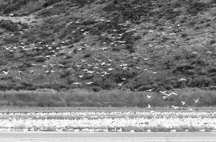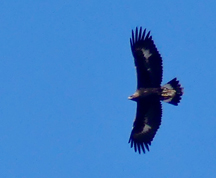Upcoming Climate Change Presentations
Dr. John Alexander, Executive Director of the Klamath Bird Observatory, will speak about climate change at two upcoming events. He will be the featured speaker at next Rogue Valley Audubon Society (RVAS) monthly meeting November 28, 2017 and will join other local scientists at Klamath-Siskiyou Wildlands Center’s (KS Wild) “Your Climate Refuge: hotter, drier, and no less wild” event November 29, 2017.

John will share what critical impacts climate change is having on regional and national bird populations, and summarize research that KBO is undertaking in his talk “Climate Change: A Bird’s Eye View”. Recent research suggests that the challenges bird communities already face are exacerbated by climate change. As climate change brings shifts of habitats, birds can be among the first to tell the story of climate trends. Just like the canary in a coal mine they may alert us to what is happening and what the future holds, if we are paying attention. The U.S. Department of Interior’s 2010 State of the Birds Report on Climate Change, to which Klamath Bird Observatory contributed, addressed this critical issue.
Both meetings are open to the public—join us to learn about international, national, and regional efforts to adapt bird conservation and natural resource management strategies to effectively meet the most urgent needs in the face of climate change.
 The RVAS’s monthly meetings are held at the Medford Congregational Church Lidgate Hall at 1801 E. Jackson Street in Medford beginning at 7 pm. Their next meeting is November 28, 2017. Click here to learn more about RVAS and their upcoming events.
The RVAS’s monthly meetings are held at the Medford Congregational Church Lidgate Hall at 1801 E. Jackson Street in Medford beginning at 7 pm. Their next meeting is November 28, 2017. Click here to learn more about RVAS and their upcoming events.
 KS Wild’s “Your Climate Refuge: hotter, drier, and no less wild” event takes place at Southern Oregon University’s Stevenson Union, Room 330 on November 29, 2017 6 pm – 8 pm. Click here to learn more about this and other upcoming KS Wild events.
KS Wild’s “Your Climate Refuge: hotter, drier, and no less wild” event takes place at Southern Oregon University’s Stevenson Union, Room 330 on November 29, 2017 6 pm – 8 pm. Click here to learn more about this and other upcoming KS Wild events.







 The Douglas County Global Warming Coalition is pleased to partner with the Umpqua Valley Audubon Society to present Climate Change — A Bird’s Eye View: How Global Warming Impacts Birds of the Pacific NW. Tuesday, October 17 from 7:00 to 8:30 PM at the Holiday Inn Express in Roseburg, Oregon.
The Douglas County Global Warming Coalition is pleased to partner with the Umpqua Valley Audubon Society to present Climate Change — A Bird’s Eye View: How Global Warming Impacts Birds of the Pacific NW. Tuesday, October 17 from 7:00 to 8:30 PM at the Holiday Inn Express in Roseburg, Oregon. The plan is the product of more than a year’s work by partners of the Cascadia Prairie-Oak Partnership, American Bird Conservancy, Center for Natural Lands Management, Klamath Bird Observatory, Willamette Partnership, and Pacific Birds Habitat Joint Venture. A companion document, Prairie, Oaks and People – Profile Projects, showcases 21 projects that support the goal and objectives outlined in the business plan. Profile Projects is intended to be a dynamic compilation of projects that partners can contribute to over time.
The plan is the product of more than a year’s work by partners of the Cascadia Prairie-Oak Partnership, American Bird Conservancy, Center for Natural Lands Management, Klamath Bird Observatory, Willamette Partnership, and Pacific Birds Habitat Joint Venture. A companion document, Prairie, Oaks and People – Profile Projects, showcases 21 projects that support the goal and objectives outlined in the business plan. Profile Projects is intended to be a dynamic compilation of projects that partners can contribute to over time.
